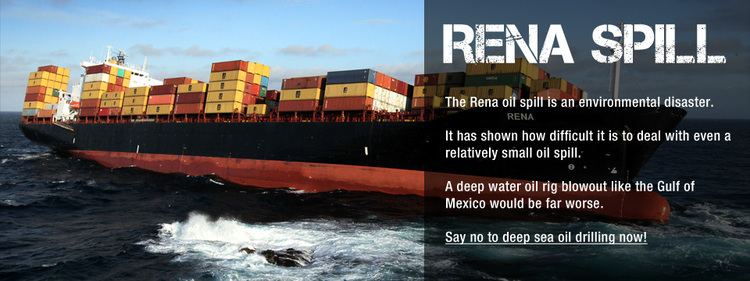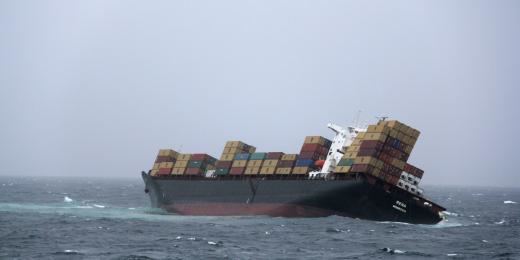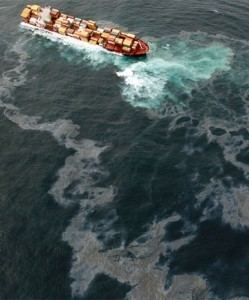Date 5 October 2011 | ||
 | ||
Volume Up to 2,500 barrels (400 m) Similar Gulf War oil spill, Exxon Valdez oil spill, Greenpoint oil spill, MV Tasman Spirit, Ixtoc I oil spill | ||
Releasing the penguins rescued after rena oil spill
The Rena oil spill occurred off the coast of Tauranga in New Zealand. The spill was caused by the grounding of MV Rena on the Astrolabe Reef. The Rena was a container ship and cargo vessel owned by the Greek shipping company Costamare Inc., through one of its subsidiary companies, and chartered by the Mediterranean Shipping Company (MSC). The spill has been described as New Zealand's worst maritime environmental disaster.
Contents
- Releasing the penguins rescued after rena oil spill
- Army clean the beaches after the rena oil spill off the coast of tauranga
- Sequence of events
- Media coverage and public reactions
- Cleanup
- Salvage teams
- Environmental impact
- Political consequences
- Criminal charges
- Treaty of Waitangi case
- Past spills
- References

Army clean the beaches after the rena oil spill off the coast of tauranga
Sequence of events

On Wednesday, 5 October 2011, at 2:20 AM (Tuesday, 4 October 13:20 UTC) while sailing in clear weather from Napier to Tauranga, at a speed of 17 knots (31 km/h; 20 mph), Rena ran aground on the Astrolabe Reef. The ship was carrying 1,368 containers, eight of which contained hazardous materials, as well as 1,700 tonnes of heavy fuel oil and 200 tonnes of marine diesel oil. Initially the ship listed 11 degrees to port, with the front stuck on the reef.

By Sunday, 9 October 2011, a 5 kilometres (3.1 mi) oil slick threatened wildlife and the area's rich fishing waters.
Oil from Rena began washing ashore at Mount Maunganui beach on 10 October 2011. Bad weather that night had caused the ship to shift further onto the reef, and the crew was evacuated. The shifting of the ship caused further damage, resulting in a further 130 - 350 tonnes of oil leaking.
Strong winds and bad weather on the night of 11 October 2011 caused the ship to list over to starboard 19 degrees; this resulted in between 30 and 70 containers being washed overboard. None of the containers contained hazardous cargo. Containers subsequently began washing ashore on Motiti Island.
On the afternoon of 12 October 2011, aerial footage showed a large crack in the hull, increasing fears that the ship could break in two and sink. It also showed a container floating in the water surrounded by smoke, suggesting that a chemical reaction was occurring.
On 13 October 2011, Maritime New Zealand ordered beaches from Mount Maunganui to Maketu Point, including the Maketu Estuary, to be closed to the public. Volunteers were warned that contact with spilled oil could lead to vomiting, nausea and rashes, and local residents were urged to close their windows to limit fumes.
Costamare Shipping, the owners of Rena, apologised to the people of Tauranga, saying they were "deeply sorry" for the "disastrous event." Although not legally obligated to do so, the charterer, Mediterranean Shipping Company, promised to help with the cleanup costs.
On 14 October 2011, it was reported that the ship's hull had cracked in half, and the bow and stern sections were held together only by internal structures and the reef. Calmer weather meant that preparations could be made to pump out the remainder of the ship's oil, but a change in the wind direction meant that oil was likely to spread as far east as Whakatane and Opotiki.
Also on 14 October 2011, the Filipino crew of the Rena left New Zealand "for their safety" after a racist backlash against Filipinos in Tauranga.
Calm weather on 15 October 2011, allowed salvage experts to board the vessel and begin preparations to pump the remaining oil to a barge. Platforms were attached to the side of the ship, and pumping began on 16 October 2011. By 17 October only twenty tons of oil had been removed.
On 16 October a mine-countermeasures team aboard HMNZS Manawanui began hunting for spilled containers.
After October, salvage efforts were focused on removing the ship's cargo before it completely broke apart.
In January 2012, the Rena completely broke in half and the stern section slipped off of the reef and eventually sank. A small amount of oil and containers escaped the ship as it broke in half.
By 23 March 2012, 649 containers of cargo had been recovered and it was thought that only a few tens of tonnes of oil still remained in the ship.
Media coverage and public reactions
The incident was not immediately brought to the public eye since it took place on 5 October 2011, the same day the well-known American businessman Steve Jobs died. In addition, media outlets had their hands full with the Occupy Wall Street Movement that was taking place. Information about the oil spill did not surface on major news websites until four days later when CBC News published an article on 9 October 2011. British newspaper The Guardian then released a piece on the incident on 10 October 2011, followed by the BBC on 11 October 2011.
Residents of Motiti Island voiced their concerns over the effects the oil spill was having on their lifestyles, since they relied on water filled in tanks and seafood from the affected waters for survival. It cost islanders approximately $100 to leave the island for food or water; this expense along with the toxic water and seafood raised concern among the citizens of Motiti Island that their lives might never be the same.
New Zealand environmental minister, Nick Smith, said that the impact of this spill was the most significant in New Zealand history. Reporter Karen Barlow of Lateline said that it may not be the biggest ever oil spill, but it could be catastrophic for the pristine waters of the Bay of Plenty. World Wildlife Fund spokesperson, Bob Zuur, confirmed a major loss of wildlife.
Cleanup
"The cleanup for the Rena Oil spill will take time," said New Zealand scientist Dr. Norm Duke. "Petroleum oil will naturally break down - but this takes time and oxygenation. So, the longer the oil remains floating at sea - the safer it becomes. And, the rougher the weather - the better also."
Maritime New Zealand used the oil dispersant Corexit 9500 to help in the cleanup process. Corexit is known to increase the toxicity of oil. The dispersant was applied for only a week, after results proved inconclusive.
Salvage teams
Environmental impact
Political consequences
The disaster occurred only seven weeks prior to the 2011 general election (which took place on 26 November 2011) and partially affected the campaign. On 14 October it was reported that the disaster had caused a 4% drop in the governing National Party's polling on the iPredict prediction market.
On 13 October 2011, the New Zealand Labour Party announced that it would impose a moratorium on deep sea drilling for oil if elected to power.
In 2012 the government announced a twelve-month environmental recovery plan for the area with an expected cost of NZ$2–3 million (US$1.6M–2.5M as of January 2012).
Criminal charges
On 12 October 2011, the captain of Rena appeared in the Tauranga District Court charged with operating a vessel causing unnecessary danger or risk to a person or property. He was granted name suppression and remanded on bail. If convicted he faced a fine of up to $10,000 or up to 12 months imprisonment. The ship's second officer, who was responsible for navigation at the time of the accident, was subsequently charged and appeared in court on 13 October.
The two men, both Filipino, pleaded guilty to 11 charges between them, including attempting to pervert the course of justice (based on alleged alteration of navigational documents after the collision). The sentencing for both men was scheduled for 25 May 2012.
The (New Zealand) Transport Accident Investigation Commission released an interim report into the grounding on 8 March 2012. The report states only what happened but not why, and does not apportion blame. It states that Rena arrived at the port of Napier and began unloading cargo, but was forced to stand off in the harbour when a ship with priority booking arrived. Rena was therefore delayed 13 hours in leaving Napier. On making the run toward Tauranga, the captain was under pressure to make up time and to arrive at the port's pilot station by 3:00 am, and the ship's charts showed that a more direct course than usual had been set that took Rena toward Astrolabe Reef. An intermittent radar echo first noticed at 2:05 am was ignored when nothing was seen through binoculars, and at 2:14 Rena struck the reef.
On 25 May 2012, the captain and navigation officer appeared in Tauranga District Court for sentencing. Each was sentenced to 7 months imprisonment.
Treaty of Waitangi case
Three Bay of Plenty iwi groups have launched a breach of the Treaty of Waitangi case against the Crown. Their key concern is that they were not adequately consulted in regard to the Crown agreeing to receive $10 million as compensation for the remains of the wreck not being removed. The government agreed to the compensation payment when a storm caused the remains of the wreck to fall off the reef onto the seabed and marine demolition experts said it was too dangerous to remove it.
Past spills
The second most extreme oil spill New Zealand has experienced since 1990 was the Jody F. Millennium log ship incident. The ship broke free from several of her moorings in Gisborne Harbour due to huge swells on Wednesday 6 February 2002. Tugboats attempted to bring the ship alongside the wharf, but it was then decided to take the ship to sea. A big swell hit the ship which then grounded on the beach. An estimated 25 tonnes of fuel oil leaked out of the ship.
